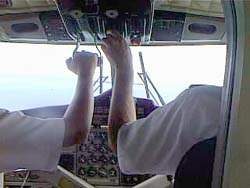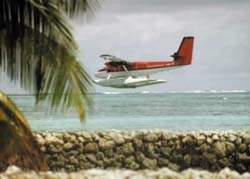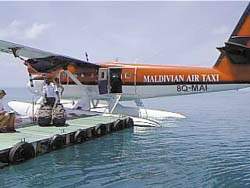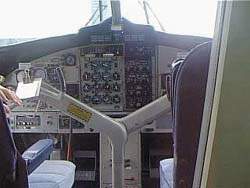 |
|||||||
|
The Norwegian bombshell
At least officially, the drama over the sea plane carrying Anton Balasingham, deviating course en route to Maldives to swoop down on a Naval cordon of Sea Tiger guerrillas on April 24, thus risking attack over the eastern seas, is now over. When it happened, the "Peace Secretariat" in the Prime Minister's Office complained to the Sri Lanka Monitoring Mission (SLMM) over the worrisome incident. The response came from the Norwegian Embassy in Colombo. They declared in a statement last Wednesday "the flight path out of Sri Lanka was decided by the pilot on the aircraft and him alone." However, the Embassy said "it is regrettable" the aircraft ended up "near the incident" between the Navy and Tiger guerrillas on the coast east of Trincomalee. If the "Peace Secretariat" has been cautious enough, since the Ceasefire Agreement, not to generate any serious controversy through complaints that may jeopardize the peace process, the sea plane saga was different. There were many compelling reasons. The Navy or the Air Force in Trincomalee, were completely unaware of the departure of Dr. Balasingham, his Australian born wife Adele and party in that red and white aircraft belonging to Maldivian Air Taxis. If they were shot down, the consequences would have been unimaginable. It could have signalled the beginning of Eelam War Four. There would have been a lot of finger pointing at the United Front Government. But providence changed the course of events. Though the issue is no longer a bone of contention for the Government, either with the Tiger guerrillas or the Norwegian mediators, the assertion that the pilot and "him alone" chose the flight path has raised more questions than it sought to answer. The reason - The Sunday Times has learnt that the Sri Lanka Navy is in possession of irrefutable evidence that the Maldivian Air Taxis sea plane, with Dr. Balasingham and party on board, descended to nearly 100 feet above the sea where Naval craft had placed a cordon on a Sea Tiger flotilla. (Situation Report - May 5) That is not all. After making the low descent, the aircraft gained altitude to make a low descent for a second time, also to nearly 100 feet, before departing from the area. The evidence is on a video captured by the MSYS (Multi Sensored Integrated System), an Israeli built piece of equipment mounted on the bridge of Dvora Fast Attack Craft (FAC) of the Navy. Usually, the video camera on board is used to photograph matters of significance on the surface like movement of enemy vessels or a confrontation. Such footage has often been released by the Navy in the past to media and have been relayed on news programmes by state run and private television stations. The Sunday Times has learnt that Navy Commander Vice Admiral Daya Sandagiri, screened the video footage obtained from the MSYS equipment to some high ranking personalities, including those in the defence establishment this week. The footage has clearly established that the sea plane circled over the Navy cordon at a lower altitude, nearly 100 feet above the sea, on two successive occasions. If as claimed, the sea plane was on its normal course to Male, after taking off from the Iranamadu Tank, it should have, by then, maintained an altitude of over 10,000 feet. In such an event, it would not have been closely observed by more than 30 Navy personnel, who had believed the aircraft was coming in to land at sea. Since the De Havilland DHC - 6 Twin Otter sea plane is not pressurized, the maximum altitude the aircraft could maintain is said to be 12,000 feet. The indisputable evidence, in the form of the video footage now in possession of the Navy, begs answers to a number of questions. Firstly, if as asserted, "the pilot on the aircraft, and him alone," decided on the "flight path," why did he choose to make a low descent over the Naval cordon ? When did he become aware that the Navy has placed a cordon around a flotilla of Sea Tiger boats ? Now to the full text of the statement issued by the Royal Norwegian Embassy: "The
Royal Norwegian Embassy has noted that it has been indicated in
several media that the flight-path chosen by the aircraft carrying
Mr. Anton and Mrs. Adele Balasingham out of Sri Lanka was on the
request of Mr. Balasingham. In this connection the Embassy feels
it is correct to provide the following information: " - All arrangements regarding the flight were cleared between appropriate representatives of the Maldivian Government, the GOSL (Government of Sri Lanka) and this Embassy. LTTE was not involved and was only informed of the time of arrival and requested to prepare for the landing and loading. " - The pilot did not provide any flight-path for his entry into or exit out of Sri Lanka. GOSL had, however, provided the pilot a "time window" for his arrival and departure. " - The passengers - including a member of the Royal Norwegian Ministry of Foreign Affairs- were unaware of any flight-path prior to their departure. The pilot approached the passengers only after they were airborne to inform that they had chosen to depart via the east coast, thereafter follow the coastline of Sri Lanka, before leaving towards Male somewhere south of Galle. " - It is regrettable that the aircraft by such route ended up near the incident between the Navy and the LTTE on the coast east of Trincomalee. These incidents were, however, in no manner connected. The flight-path out of Sri Lanka was decided by the pilot on the aircraft and him alone." Evidently, the complaint to the Sri Lanka Monitoring Mission (SLMM) by the "Peace Secretariat" over the sea plane fiasco did not make any reference to the video evidence available with the Sri Lanka Navy. The Sunday Times learnt that during Norwegian inquiries into the matter, questions had in fact been raised as to how and why the Navy did not have any pictorial record. However, the news of the existence of the footage had come only after the complaint had been lodged. In the light of the evidence that has now surfaced, the contention that the incident between the Navy and the Sea Tiger flotilla was in "no manner" connected with Dr. Balasingham's departure is proved completely wrong. If the pilot, and he alone, chose the flight path as claimed, why did he make a low descent over the Navy cordon? Why did he circle the area twice before resuming the flight? How did he become aware a Naval cordon had trapped a Sea Tiger flotilla near Trincomalee? If he was unaware, why did the pilot make a descent? Why did he choose a five and half hour route to return to Male when he could have done it in three hours by taking the route used to bring Dr. Balasingham ? Who informed the pilot of the Navy cordon ? In choosing to make a low descent, up to nearly 100 feet from the sea, did he not place the life of the guerrilla Chief Negotiator and others in peril? If by accident, the Navy or the Air Force opened fire, would not the UNF Government been blamed for sabotaging the peace talks? Would not a resultant retaliatory strike by the guerrillas, either on a military, civilian or VIP target cost lives and resulted in more blood letting? These are just a few of the multitude of questions that come to the fore. Answers to these and others will come as compelling reasons why the Government should raise issue with the Norwegian authorities once again. This incident proved that allowing a "time corridor," or a stipulated period during which a sea plane carrying Dr. Balasingham, could enter Sri Lankan air space and land, no matter what flight path it took, has turned out to be counter productive to Government interests. As one senior security official, who spoke on grounds of anonymity, explained, "if this is allowed again, they could quite legitimately, fly low over Colombo and then proceed for a landing in Iranamadu." But, The Sunday Times learnt that the Civil Aviation authorities are to now insist that aircraft bringing in Dr. Balasingham in the future should file a flight plan in advance. In its main front page story of April 28 headlined "Bala flies over Trinco drama," The Sunday Times reported exclusively that: "A sea plane carrying LTTE chief negotiator Anton Balasingham to the Maldives last Wednesday risked attack by the Air Force after it diverted course and flew low over a flotilla of boats the Navy had surrounded in the seas off Foul Point in Trincomalee. "Since
the departure of Dr. Balasingham was a top secret, both the Navy
and the Air Force in Trincomalee were completely unaware of the
presence of any foreign aircraft in the region. Naval craft which
spotted the sea plane promptly radioed the Operations Room of the
Air Force Base in China Bay. Whilst making preparations to intercept
or attack the sea plane, the Base had made urgent contact with Air
Force Headquarters to report the sighting. It was only thereafter
that they were advised to stand down. Meanwhile reports from the Maldivian capital Male say that the management of Maldivian Air Taxis is also conducting its own inquiry to ascertain the circumstances of the incident and the role of the pilot and co-pilot, both described as Canadian nationals. Future visits to Wanni by Dr. Balasingham will undoubtedly see new procedures in place even if the April 24 episode becomes a forgotten chapter. |
|||||||
|
Situation Report Archives
Copyright © 2001 Wijeya Newspapers
Ltd. All rights reserved. |
|||||||



